Basketball 4-Out, 1-In Motion Offense "Low" Plays
From the Coach’s Clipboard Basketball PlaybookDisclosure: This page contains affiliate links, which means that Coach's Clipboard receives a small commission (at no cost to you) if you make a purchase using these links.

First read 4-Out, 1-In Motion Offense. The 4-out offense can be as complicated or as simple as you want. We do not use all of these plays in one season. We pick plays that best suit our current team's personnel. Next season, as our players change, we may select other plays and options. Don't overload your players by teaching too much at once. Also see the 4-Out High plays and Quick Hitters for the 4-Out Offense.
The following plays are used with the "Low" set with our post player playing low. In teaching our 4-Out system, we first teach the basic offense(s), and then add a few of these plays as the season progresses. Here are several set plays that you can run out of the 4-Out Low offense: Big, Big-15, Big-Left, Big-Down, Big-43, Big-Double, Loyola, Florida, Double, Scissors, Loyola-2, 53, 34, 13 and 24, Black, 52-Curl, 14, weave-screen plays, Purdue, and Penn.
"Big"-Series
There are many options with the "Big" play series. Learn the basic "Big" and "Big-Down" plays, and then add other options gradually."Big"
This play is good if our inside post player can beat his/her defender 1-on-1 with a post move. Additionally, if the post defender is in foul trouble, "Big" exposes him/her to another fouling situation. Instead of fouling, he/she may simply play "soft" defense and allow us to score. We like the "hi-lo" feed from the top, as there is usually no helpside defense when the ball is at the top.See the diagrams below. O1 dribbles toward the right wing as O2 slides to the corner. O4 moves to the top and O1 passes to O4. O5 aggressively posts-up in the paint and O4 makes the "hi-lo" pass inside to O5 (oftentimes a "step-around" left-handed curl-bounce pass). O5 scores or gets fouled as the first option. The pass from O4 to O5 must happen quickly to avoid O5 getting a 3-second violation. Timing is important.
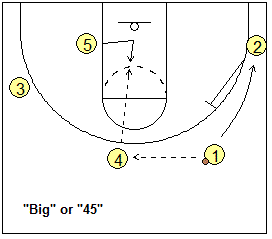
After O1 passes to O4, O2 backscreens for O1, and O1 slides to the wing-corner area. If the pass inside to O5 is denied, O4 could skip-pass over the top to O1. O1 could shoot the 3-pointer, or pass inside to O5 posting up on the ball-side. Another option when the pass from O4 to O5 is being denied is to have O4 fake a pass to O5, and make a quick dribble move to the hoop around the right side of the defender.
"15"
After you run "Big" a couple times, the defense may expect it and deny the pass from O1 to O4. In this case, O4 simply backcuts up the right side of the lane and gets the pass from O1 for a lay-up. Another option: instead of O1 passing to O4, O1 passes inside directly to O5 posting up. We call this option "15".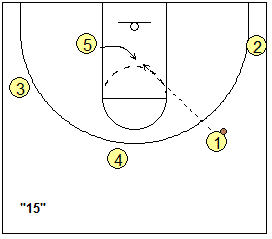
"Big-Left"
This is the same play as "Big" except that we run it on the left side. Both post players O4 and O5 move to the right side of the lane, and this opens the left lane seam for O1 to dribble-penetrate (similar to Loyola) as the first option.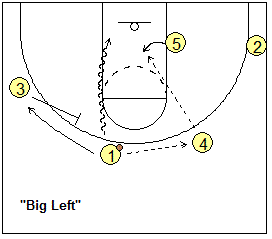
If the O1 dribble-drive is not open, O4 moves to the top right position. O2, O3, and O5 are in their usual positions. The pass goes from O1 to O4, and then O4 looks to make the hi-lo pass to O5 posting up inside, just like in "Big". The same "Big" options are in play - O3 backscreens for O1 and O4 could pass over the top to O1 if O5 is denied the inside pass.
"Big-Down" or "54"
We may have a situation where we think O4 could effectively post-up his/her defender, or maybe the X4 defender has four fouls. Now we run "Big-Down" (or "54"). This is the same play as "Big", except we start with O4 down-screening for O5, and O5 cuts up top and gets the pass from O1. O4 posts-up inside for the hi-lo pass from O5. We again have the option of O5 skip passing to O1 in the corner (diagram B).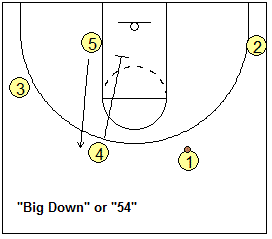
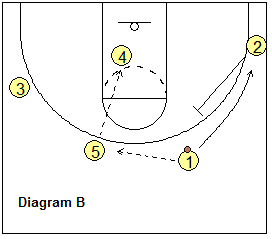
"Big-43"
This is a ball-screen "pick and pop" option using the "Big" setup. O5 moves out to the short corner for spacing inside. O1 passes to O4. O4 passes to O3, follows the pass and ball-screens for O3. O3 dribbles around the screen and attacks the top seam for a shot or lay-up. O4 pops outside to the arc. If O2's defender is in helpside, O3 could kick the ball outside to O2 in the corner for a 3-point shot. A dump pass to O5 is another option.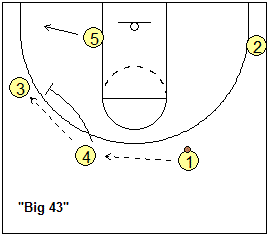
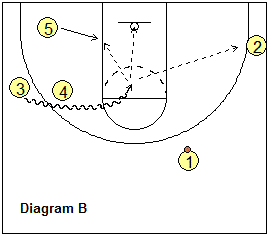
"Big-Double"
This features a double-screen for O2 for an open 3-point shot, or a dribble-drive to the hoop. The pass goes from O1 to O4 and from O4 to O3 (diagram A). O1 and O4 set a staggered double-screen for O2.O5 moves to the right block (diagram B). O2 cuts over the staggered screens looking for the pass from O3 and a 3-point shot, or a dribble-drive up the left lane line - our first options.
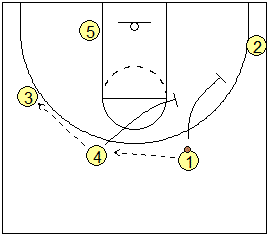
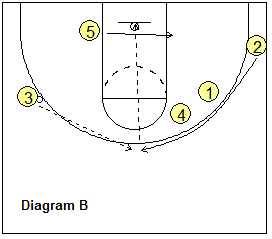
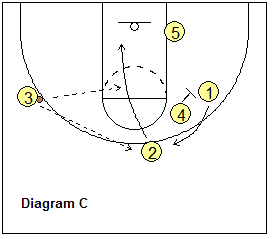
If the pass at the top to O2 is denied (diagram C), O2 back-cuts through, still looking for the pass from O3 and a lay-up. O4 screens for O1. O1 comes around the screen looking for the pass from O3 at the top. After screening, O4 moves to the right wing. O1 could shoot the 3-pointer here (diagram D).
If O1 does not shoot, O3 down-screens for O2 and O5 back-screens for O4, and O4 cuts to the hoop. A pass from O1 to any of the cutters is an option (diagram E). O2 could get a 3-point shot, or O3 and O4 could get the pass inside. If nothing happens, O1 dribbles right (diagram F) and we rotate back into the 4-out set, with O4 in the right corner, O1 and O2 on top, and O3 at the left wing.
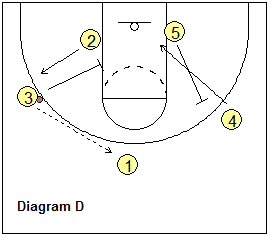
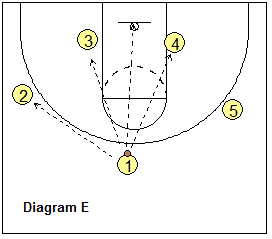
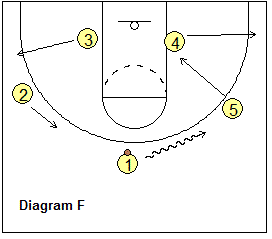
"Loyola"
We call this "Loyola" because the "L" in Loyola refers to the left seam that we want our point guard O1 to attack off the dribble. This play works well if the defense is overplaying the right side. Start in the "Big" setup (diagram A). You can also run this out of a 1-3-1 set, or a 3-out 2-in set with one post player high.Notice how the left seam opens up for O1 when O5 and O4 move to the right block and elbow, and O3 drops down to the corner.
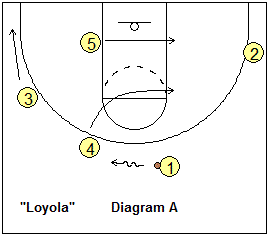
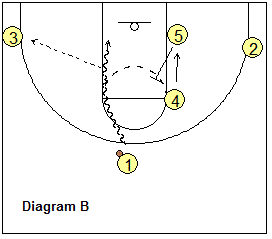
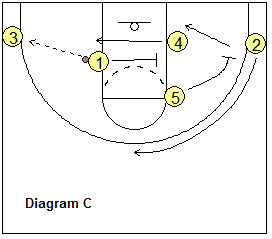
O1 dribbles left and attacks the left seam for a layup as the first option (diagram B), while O5 backscreens for O4 and then backscreens for O2. O4 moves to the block and O2 moves to the top as our safety. If O3's defender slides down and stops O1, O1 passes out to O3 in the corner (diagram C) and then O1 screens for O4.
O4 cuts to the ball-side block, as O1 moves out to the opposite corner-wing area. O3 could shoot or pass inside to O4 posting up. If O3 takes the corner shot, O5 gets back-side rebounding position for the long rebound.
"Weave-Screen Plays"
The weave screen (or "W") plays are simple hand-off plays that can free up a perimeter player for either an outside shot, or a dibble-drive to the hoop. The diagrams below show a 3-out, 2-in set, but these plays can also be run with the 4-Out and 5-Out sets. Below we see "W2", where O1 dribbles at O2 (diagram A), hands the ball off to O2 and screens the X2 defender. O2 comes around the screen for a 3-point shot, or a dribble-drive to the lane (diagram B).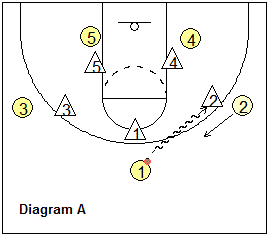
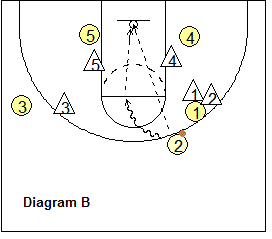
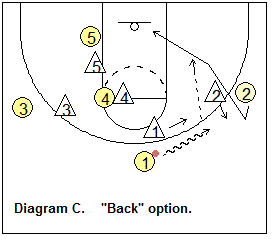
After running this a couple times, the X2 defender will often cheat out over O1 and try to jam the hand-off - here we run the "back" counter option, where O2 reads this and simply back-cuts for the pass from O1 and the lay-up.
"W3" is the same play, but run at O3. O1 dribbles at O3, and O3 gets the hand-off and shot. "W4" is the same play as "34".
"Florida"
Submitted by Mark Lane, Ohio Express Basketball and Miller Lady Falcons Basketball.This is a simple flare-screen play for an open 3-point shot for O1, or a "slip" cut and lay-up for O2. O1 passes to O4 (diagram A), as O2 comes up and flare-screens for O1. O1 cuts over the screen to the wing (diagram B) and gets the two-handed overhead pass from O4 for a 3-point shot. Another option is for O1 to feed the post O5.
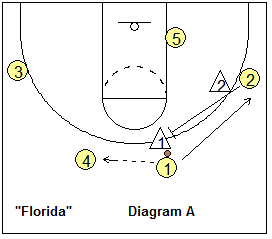
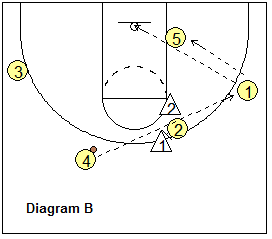
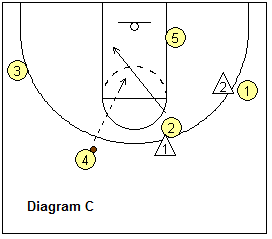
If the defense switches the flare-screen (Diagram C), O1 will not be open for the pass. Instead, O2 reads the switch, seals the X1 defender and slip-cuts to the hoop for the pass and lay-up.
An important pointer: make sure that the flare-screen is set high enough, almost at the lane line extended, as this creates good spacing for the pass to the wing O1. If that screen is set too low, usually the spacing is poor for the pass to O1.
"Double"
Submitted by Mark Lane, Ohio Express Basketball and Miller Lady Falcons Basketball.It's "double" because of an inside double-screen for O1. O1 passes to O4 (diagram A). Note that O3 has moved inside below O5 to set a double-screen for O1. O1 cuts around the screens to the ball-side corner, as O4 dribbles down to the wing and might pass to O1 in the corner for a 3-point shot.
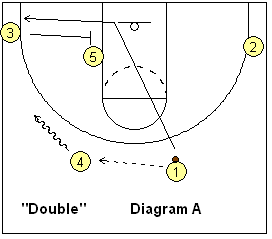
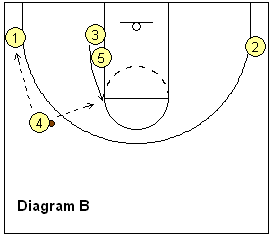
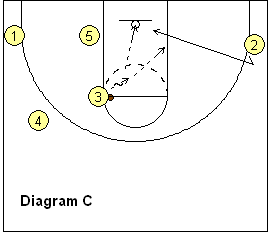
After O1 clears the double-screen, O3 cuts around O5 to the ball-side elbow and gets the pass from O4 (diagram B). O3 shot-fakes and dribbles into the paint for a possible short jump-shot, or could pass to O2 back-cutting from the right corner (diagram C).
"Scissors"
Submitted by Mark Lane, Ohio Express Basketball and Miller Lady Falcons Basketball.O5 starts low (either side) and cuts to the free-throw line and gets the pass from O1 (diagram A). O1 and O4 "scissors-cut" around O5 (diagram B) and either one could get the hand-off or a "dump-down" bounce-pass from O5. The two cutters time their cuts so they are not simultaneous and running into each other. Have O1 cut first and then O4, or vice-versa. After cutting, both move out to the corners, as O2 and O3 rotate up to the wings. Although not shown here, another option (if you have an athletic O5): after both cutters clear, O5 shot-fakes and attacks the defender 1-on-1 with a dribble-drive to the hoop.
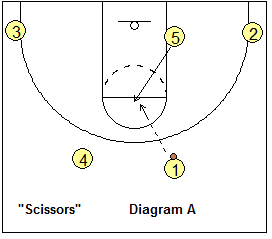
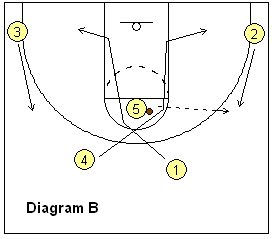
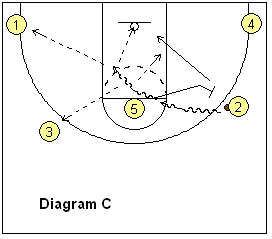
If nothing develops, O5 passes out to either wing, follows the pass and ball-screens for the wing (O2 in diagram C), for a pick and roll with the wing player. O2 looks to attack off the screen for either a pull-up jump-shot, a lay-up, a pass to O5 rolling inside off the screen, or a kick-out pass to either O3 or O1 for 3-point shots. If O2 stops short on the dribble, O3 could back-cut to the hoop for a pass from O2 and a lay-up.
See the complete article in the members section.
Sign up now!
The complete article also includes:
- Loyola-2 - This play is similar to the "Loyola" play.
- 53 - This is a simple back-screen, pin and roll play.
- 34 - for a good athletic O4 who can shoot or attack the basket.
- 13 and 24 - "13" and "24" are the same play, except run to opposite sides.
- Black - run this left or right... the opposite top perimeter player, down-screens for the lower perimeter player.
- 52-Curl - a good play for an athletic O2, especially if O2 is left-handed.
- 14 - a good play if we have an athletic O4 who can shoot or attack the basket.
- Purdue - This play is unusual in it's simplicity.
- Penn - This play starts like "Purdue", but gives O2 a chance to attack the top left seam.
Related pages:
- Jay Wright's 4-Out Offense
- How to Use Your Post Player in the 4-Out Offense
- Quick Hitters for the 4-Out Offense
- 4-Out, 1-In Motion Offense "High" Plays